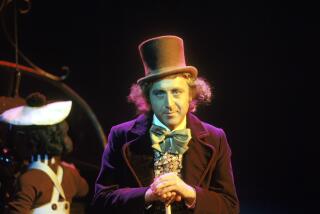Gene Kelly Dies; Legendary Dancer Was 83
Gene Kelly, the exuberant, charismatic hoofer who danced, sang, smiled and splashed his way into the hearts of generations, died Friday after several years of declining health. He was 83.
As respected as he was likable, Kelly “died peacefully in his sleep” in his Beverly Hills home with his wife, Patricia, at his bedside, according to his publicist, Warren Cowan. Kelly had suffered strokes in 1994 and 1995 and had been in ill health since then.
His life was the stuff of a Hollywood musical. Kelly was a would-be baseball player and failed law student who once made money teaching basic dance steps in the basement of his parents’ Pennsylvania home. After a few Depression-era amateur contests, he conquered Broadway and then Hollywood, starring in such films as “Singin’ in the Rain,” “On the Town” and “An American in Paris.” Along the way, he revolutionized motion picture choreography and achieved success as a director and producer as well.
Debbie Reynolds, who co-starred in “Singin’ in the Rain,” remembered Kelly on Friday as “a great dancer . . . a cinematic genius [whose] work will influence films forever.”
“He made me a star,” she said after hearing news of his death. “He taught me how to dance and how to work hard, to be dedicated and yet still loving, as he was to his family and friends.”
Charles Champlin, former arts editor of The Times, called Kelly’s classic swing around a lamppost in the film with Reynolds “the high point of solo screen dancing . . . an absolute masterpiece of the dance form.”
Judy Garland, in 1942, was Kelly’s first dance partner on the big screen. Later came Fred Astaire, Rita Hayworth, Frank Sinatra, Leslie Caron, Reynolds, Donald O’Connor, Shirley MacLaine and many others.
But of all Kelly’s dance partners, none was more memorable than an umbrella.
“Singin’ in the Rain,” the beloved, campy 1952 Hollywood spoof with Reynolds and O’Connor, provides the lasting image of Kelly’s winning screen persona: an affable, optimistic man with a crooked Irish grin and soft spot in his heart. Often called the best musical ever made, the film also showcased Kelly as a virile heartthrob, opposite the leggy Cyd Charisse in the sultry “Broadway Ballet.” Another classic number from that film--”Gotta Dance”--said much about the man.
“At 14 I discovered girls,” Kelly told his entertainment peers when the American Film Institute honored him with its life achievement award in 1985. “At that time dancing was the only way you could put your arm around the girl. Dancing was courtship.
“Only later did I discover that you dance joy. You dance love. You dance dreams.”
Kelly’s most memorable credits show a pattern of American archetypes: Runyonesque entertainers, sailors on leave, and an expatriate artist in love with a French girl. Kelly also won praise for straight drama, such as his portrayal of a glib, cynical newspaperman based on the legendary H.L. Mencken in “Inherit the Wind,” the 1960 film with Spencer Tracy and Fredric March.
Unlike Astaire, the older friend with whom Kelly was frequently compared, top hat and tails were not his style. Rather, Kelly, who stood 5-foot-9 and weighed 165 pounds, presented the dancer as the common man--a regular guy who looked good in a sailor’s uniform, or all wet, stomping in a puddle and splashing a beat cop. Most typically, his screen image was casual: sport shirts and slacks, with white socks to draw attention to those dazzling feet.
For all the casualness, Kelly was a serious student and teacher of his art.
“My own style [of dance] is strong, wide open, bravura,” Kelly said in a 1969 interview. “I tried to base it all on male movements, athletic movements.
“I wanted to do new things with dance, adapt it to the motion picture medium. Once I broke the ice, they let me do pretty much what I wanted.”
Born in Pittsburgh on Aug. 23, 1912, Eugene Curran Kelly was the middle of five children of Irish Catholic parents. They had a faint trace of show business in their blood: his father sold gramophones and his mother acted with a local stock company. It was his mother who insisted that 8-year-old Eugene take dancing lessons.
“My mother sent my brother and me to dancing school in those Buster Brown collars, and we had a minimum of three fights every week walking between our house and the school,” Kelly once said. “The funny thing is that nobody called us sissies when we served Mass in those collars, only when we went to dancing school.”
*
After a year of lessons, young Gene persuaded his mother to let him play ball instead. In high school he was a four-sport star--baseball, football, hockey and gymnastics--but he also discovered that dancing impressed the girls.
“I was a little short then and looking back I can see it was pure self-aggrandizement,” Kelly once said. “I wanted everybody to say, ‘Gee, he’s clever.’ And they did, too. It worked. I’d do a buck-and-wing”--a style of tap dance where the legs fly out to the side--”and they all thought it was nifty. But I hated it at the time.”
He entered Pennsylvania State College, but soon he left school and helped support the Kelly clan by pumping gas, working in construction and teaching gymnastics at a summer camp. Resuming studies at the University of Pittsburgh, he majored in journalism and participated in student theater. To make a little extra money, he and his brother Fred created a song-and-dance act for local nightclubs and talent contests.
After graduation, Kelly spent some discouraging months in law school. Abandoning that notion, he and Fred founded the Kelly Studios of the Dance in the basement of the family home. It was such a success that they opened a second studio in nearby Johnstown.
The lure of Broadway ended those ventures. After some small stage roles in the late 1930s, Gene Kelly got his big break in William Saroyan’s “The Time of Your Life”--a natural as Harry, the good-natured hoofer. Then came his title role performance as the shifty nightclub entertainer in “Pal Joey,” the Richard Rodgers and Lorenz Hart musical. He also won praise for choreography in George Abbott’s “Best Foot Forward,” a Broadway hit of 1941.
The next year, Metro-Goldwyn-Mayer, churning out its sumptuous musicals, gave Kelly an auspicious screen debut opposite Garland in “For Me and My Gal.” He made seven more films in the next three years, earning an Oscar nomination for his role as a brash sailor in “Anchors Aweigh,” a 1945 box office hit with Sinatra and Kathryn Grayson.
Kelly then served a two-year stint in the real Navy as a lieutenant, making training films. Returning to MGM, he signed a three-way deal as a performer, director and producer.
Two swashbuckling 1948 roles, as the acrobatic D’Artagnan in George Sidney’s opulent production of “The Three Musketeers” and, especially, as the lead of Vincente Minnelli’s “The Pirate,” gave Kelly a reputation as the Douglas Fairbanks of dance. Another 1948 film, “Words and Music,” a fictionalized biography of the musical team Rodgers and Hart, won Kelly acclaim for his ballet to the tune “Slaughter on Tenth Avenue,” performed with Vera-Ellen.
His artistic reputation was assured over the next few years, due in part to a winning collaboration with writer-director Stanley Donen. Kelly and Donen wrote the original story for “Take Me Out to the Ball Game,” a turn-of-the-century musical starring Kelly, Sinatra, Esther Williams and Jules Munshin. Next came the artistic breakthrough “On the Town,” featuring Kelly, Sinatra and Munshin as three sailors on a 24-hour leave in New York City.
Co-directed by Kelly and Donen, “On the Town” was an unprecedented merger of ballet and Hollywood musical. Away from sound stages for a change, Kelly and Donen produced several dance numbers on location in New York, an unusual method for its time, and pioneered a variety of cinematic techniques in the process.
Then, in 1951, Kelly worked with Minnelli again on “An American in Paris,” co-starring with then-18-year-old Leslie Caron. The film won eight Academy Awards, including best picture. Kelly was awarded a special Oscar “in appreciation of his versatility as an actor, singer, director, and dancer, and specifically for his brilliant achievements in the art of choreography on film.”
Thirty-four years after the fact, Caron recalled spending her first night in America at Kelly’s Beverly Hills home:
“All the hoofers from the MGM lot would come to Gene’s for the Saturday jam sessions. I shall never forget Gene doing his Irish best behind the bar, while Lena Horne--and then it was Judy Garland--sang, and Andre Previn played piano. Oscar Levant taught me how to smoke, nervously, and Stanley Donen slept.”
*
For all the accolades for “An American in Paris,” it was the next film that would define Kelly for years to come. “Singin’ in the Rain” became such a classic that, a generation later, the bleakly futuristic “A Clockwork Orange” featured its anti-hero doing a sadistic parody of Kelly’s umbrella dance. And still later, at the 1985 AFI tribute, the cake was adorned with little chocolate umbrellas.
The umbrella had become Kelly’s trademark, but dance aficionados had always appreciated his use of so-called “found” objects--newspapers, lampposts and puddles. The 1955 film “It’s Always Fair Weather” opens with the unlikely scene of Kelly, Dan Dailey and Michael Kidd doing a kind of soft-shoe with garbage can lids attached to their feet.
His first solo effort as a director, “An Invitation to the Dance” in 1956, demonstrated Kelly’s predilection toward artistic experimentation. Performed completely without dialogue, the film consists of three unrelated episodes with Kelly accompanied by classically trained ballet dancers.
Age slowed Kelly as a performer, but did nothing to diminish his creative drive. Increasingly, the self-described “jack of all trades” turned more to choreography, directing and producing--but still found time for occasional performing roles.
On stage, his credits included the direction of Rodgers and Hammerstein’s “Flower Drum Song” in 1958. Kelly also accepted the Paris Opera’s invitation to choreograph a new ballet for its resident company. His pas de deux to George Gershwin’s “Concerto in F” was, to say the least, a success. It received 27 curtain calls on its premiere in 1960, and the French government later made Kelly a chevalier of the Legion of Honor.
*
On the big screen, he directed six films between 1957 and 1969, ranging from the experimental “Gigot” with Jackie Gleason in 1962 to the big-budget box office hit “Hello, Dolly!” with Barbra Streisand in 1969. He also found time for the small screen, hosting and performing in numerous television specials and variety shows, as well as occasional dramatic roles.
Fans who grew old with Kelly--plus a new generation weaned on rock ‘n’ roll--were dazzled anew when MGM celebrated its 50th anniversary in 1974 with the release of “That’s Entertainment!” a documentary compilation of scenes from the studio’s musicals. Its success spawned “That’s Entertainment, Part 2.” Kelly directed bridging sequences for the sequel--and choreographed a special number for himself and Fred Astaire.
“I’ll never starve,” he told an interviewer in 1976. “My only problem is learning how to loaf. . . . I still find it almost impossible to relax for more than one day at a time.”
His last dance for the cinema was in “Xanadu,” a 1980 musical fantasy with Olivia Newton-John that was a box office flop.
In the 1980s, Kelly did what many other aging stars do: television commercials. He also went on tour offering “An Evening With Gene Kelly” to his legion of fans. In 1985, he was executive producer of the film “That’s Dancing!”
Kelly was married three times and fathered three children. He and his first wife, actress Betsy Blair, were married 17 years before divorcing in 1957. They had a daughter, Kerry. In 1960, he married Jeanne Coyne. They had a son, Timothy, and a daughter, Bridget. Kelly was widowed in 1973.
In 1984, fire struck the Kelly home on Rodeo Drive. He and his children stood outside and watched the massive Craftsman-style home burn to the ground, destroying a career of memorabilia, including his only Oscar. Kelly rebuilt the home on the spot.
In 1990, at the age of 77, Kelly married writer Patricia Ward, 41 years his junior. They were collaborating on a book at the time of his death.
Kelly’s dual achievements in show business and high art were noted in the 1985 AFI tribute, as such contemporary dance figures as Mikhail Baryshnikov and Gregory Hines offered testimonials.
“One night I invented a dance step,” recalled Hines, the tap dancer. “And then a few weeks later I turned on the TV and saw ‘Take Me Out to the Ball Game.’ Suddenly I saw Gene doing the step I’d made up.”
When Kelly took the dais, the tone briefly took that of a confessional.
“It’s all true,” he said. “It’s true I didn’t want to be a dancer. What I really wanted to be was shortstop for the Pittsburgh Pirates.”
“The Pittsburgh Pirates,” he added with a grin, “lost a hell of a shortstop.”
More to Read
Only good movies
Get the Indie Focus newsletter, Mark Olsen's weekly guide to the world of cinema.
You may occasionally receive promotional content from the Los Angeles Times.










